This case study outlines three female patients who presented to a World Health Organisation (WHO) battlefield trauma hospital in Mosul, Iraq, reportedly suffering from chlorine gas exposure post explosion. All three patients experienced critical symptoms that strayed from regular chlorine exposure and pushed the capability of our facility to its limit. Many unique features of this case present themselves but the outstanding feature is highlighted through the staffing model. This model was led by the local Iraqi healthcare team and supported by only a small team of skilled foreign staff members from various European nations, North America and Australasia. The team was tasked with delivering acute trans-cultural care, providing significant intercultural learning and education opportunities and absolute situational awareness. A key determinant from the case was the understanding that more education could be focused on ethical decision-making before, during, and after deployment that incorporates local cultural and political sensitivities. Fundamental to this experience is the recommendation from an organizational wellness perspective is to ensure the team debrief and decompress from such intense scenarios to help negotiate anxiousness, worry and helplessness.
Islamic state swept through Northern Iraq in 2014 and seized Mosul as their new Iraq headquarters. Within this ancient city the group’s leader Abu Bakr al-Baghdadi declared a new caliphate and sent a statement within a video recording across the globe, establishing Islamic State as an emerging force within the Middle East. It was not until October 2016 that the Iraqi army and allies were able to collectively prepare and engage a new offence to retake Mosul. During this time healthcare across the city had been decimated. Islamic state had retained within the old town an approximate hostage population of 30–40,000 civilians by delivering fear, torture and death to those that attempted to escape. In March 2017, various news reports outlined details that chemical attacks had been undertaken by Isis in Mosul with the International Committee of the Red Cross (ICRC) receiving and treating 12 such patients. The use of chemical weapons is a war crime. These attacks in March were reported to be severe burns and blisters likely being mustard gas. This case study details the possible use of chlorine gas. In July 2017, during the authors' deployment, Mosul was liberated from Islamic State by the Iraqi army.
Three female patients, ranging from 14-28 years old, were admitted to a small battlefield trauma hospital 15km South of Mosul, Iraq. All three patients presented with respiratory distress, decreased level of consciousness and a notable rash across their torso. These symptoms were reportedly due to possible significant exposure to chlorine gas post explosion.
Literature regarding chlorine exposure predominantly relates to accidental or industrial exposure not incidents within military or warfare scenarios. The toxicology of chlorine is related almost entirely to effects in the respiratory system ranging from sensory irritation, bronchospasm, cellular changes within the bronchioles and alveoli, to eventual development of pulmonary disease [1]. Local oedema secondary to active arterial and capillary hyperaemia develops due to irritation of the airway mucosa, which progressively with the plasma secretion, the alveoli are filled with oedema fluid, resulting in pulmonary congestion and dose-dependent epithelial cell injury [2].
On admission
All three patients arrived within two hours of each other via ambulance and on arrival all patients presented critically unwell. The patients were reported through our referral system via NYC medic’s and other Non-government organisations (NGO) depending on patient needs from the front lines of the warfare. As our facility had the capability for managing such patients they were immediately referred due to the mechanism and history of the reported incident. Due to requirements for decontamination, immediate vital sign data collection was not possible as the patients were triaged from the ambulance to undergo decontamination showering. Decontamination, as with most chemical exposures, involves evacuation of the patient from the area of exposure, removing clothing, and irrigating all body surface area with copious amounts of water [3] (Figure 1).
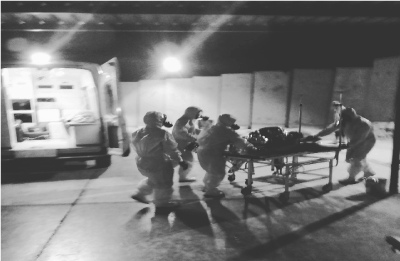
Figure 1. Staff admitting a patient upon arrival for decontamination. Full Rigourous PPE was required to ensure the safety of everybody across the camp.
On presentation the victims had appropriate oropharyngeal airways insitu. No supply of oxygen. No accompanying medics. No other medical therapy noted to be initiated. A primary assessment was undertaken. Airways were being maintained although significantly at risk due to decreased neurology. All patients were tachypneaic with respiratory rates > 35bpm with significant associated work of breathing. Patients were pink and warm to touch with a radial pulse denoting that perfusion was adequate for essential end organ function. One patient experienced extremely large stool output. Neurology was poor. GCS of all patients was 6-8. No seizures noted. Patients were striped naked on trolleys with dignity maintained. It was recorded that a notable rash was present across the trunk on two of the three patients (Figure 2).
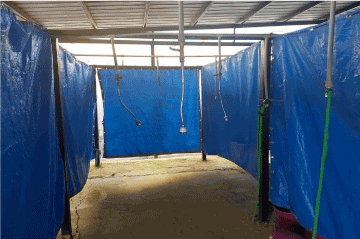
Figure 2. Decontamination showers
Once the women were decontaminated their bodies were covered for dignity and moved from out of the decontamination unit, and transferred into the emergency department for ongoing management. It was noted that all three females wore gold jewellery, were of a healthy body weight and appeared to have make up on. This was very unusual for most civilian patients during this period as most were malnourished and living in desolate poverty. It was proposed that perhaps they were the wives of local ISIS soldiers.
Symptomatic therapy
Due to the presence of the rash, the immediate differential diagnosis, with the reporting handover was chlorine exposure. To accompany this staff noted burning eyes post decontamination and a strong smell was present across all three patients, a few reported the smell to be of swimming pools i.e. chlorine and others reported a strong garlic smell. Our immediate goal was to ensure maximal supportive measures were initiated, with a primary goal of restoring and maintaining oxygenation, intravascular volume and electrolyte balance. The patients were considered to be at high risk for respiratory failure and hypovoleamic shock.
Our immediate ventilatory supportive measures were limited. Within the facility oxygen was not endless and the resources to intubate and ventilate were absolutely restricted with the presence of only one mechanical ventilator, which was working sufficiency and one that was faulty. Upon assessment post decontamination, work of breathing did settle and realised oxygenation was sufficient with Sp02 of 93-96% on facemask oxygen of 6L. After 4-6 hours it became apparent very quickly that all three patients were bleeding. One patient bled from the ears and the two other patients from the nose and mouth. One patient hemorrhaged to the extent that her face mask filled with blood and required emptying every 15 minutes due to the volume of blood coming from her nose and mouth. Transaexamic acid was administered with nil effect. One unit of red blood cells was given to replace the loss. It was at this point that we realised we had reached the limit of our care. This notably did not fit within a differential diagnosis of chlorine exposure and or Sarin gas. It was then decided collectively that these patients should be managed as a possible biological exposure due to the quick onset and severity of their blood loss.
Initial history at this point was only the verbal story relating to chlorine, but it was evident that we did not have the capacity to cope with these signs and symptoms.
Very strict infection control measures were instigated with a segregated area allocated and associated staff who were already possibly exposed to remain with the patients rather than risk further exposure across the camp. Nobody within the facility could explain the bleeding. Chlorine is described to cause respiratory irritation but not specifically haemorrhage. Other agents such as Sarin, which ISIS have been recorded to use, also do not cause pulmonary haemorrhage [4]. Given the absence of trauma, staff identified the possibility that these patients had been exposed to a biological weapon rather than a chemical weapon. Our resources for blood pathology were limited and testing capabilities near zero. At the time the only availability for understanding the agent responsible would require samples to be obtained by the Iraqi government and transported and analysed in Baghdad. This would take days. From onset of bleeding all patients died within twelve hours. All died through significant pulmonary haemorrhage (Figures 3-5).
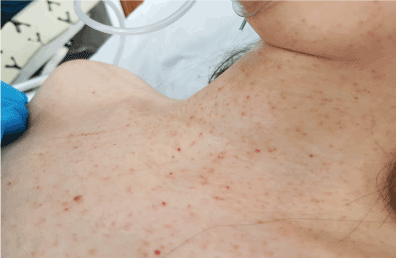
Figure 3. Rash upon presentation, extensive across neck, limbs and trunk.
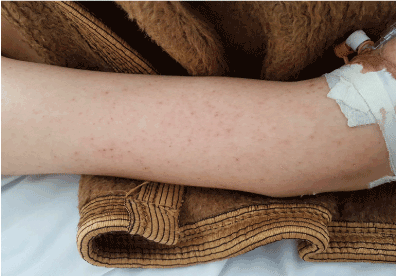
Figure 4. Rash across limbs
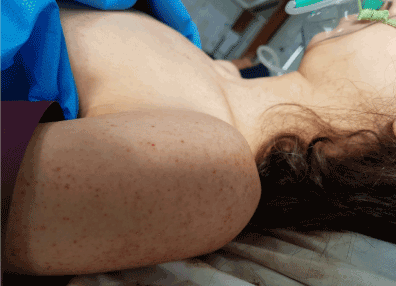
Figure 5. All patients presented with various surface areas of this rash
Availability of testing
Within our facility limited pathology testing was available. Full blood count, electrolytes were variably available. Unfortunately, no chlorine testing resources were immediately accessible. From a transfusion perspective whole blood and fresh frozen plasma was available and one patient was administered red blood cells due to blood loss. As a major incident was activated during the evening representatives from WHO presented the next day to talk through the cases and their clinical course to understand what occurred. It was discussed that due to the presenting information and pre-dominant clinical details that it was indeed likely to be significant chlorine exposure. If it was to be biological, it would most likely have been Crimean Haemorrhagic Fever but this was very unlikely. Due to political sensitivities with the Iraqi government it was not possible to simply take blood samples and send them to WHO lab for analysis. This required the Iraq Department of Health to undertake the governance for such testing. This did not occur.
Inter-cultural practice and education
Throughout our deployment the relationship between local and expat staff was vital. The unique model of local staff maintaining clinical decision-making did provide challenges but were negotiated through regular and transparent communication. Variant dynamics were present such as having a neutral healthcare facility required that any ISIS soldiers and or ISIS family members requiring treatment would come through and be treated by our staff. This posed very acute and prominent challenges that ensured all staff maintained core principles of professional care delivery and the protection of human rights. The challenge before the team was outlined in our culture. Each foreign team member had their own cultural background; their own education and understanding of diversity and all contained a wide range of abilities to relate to others with differing cultures. This was also present across the Iraqi team with varying presence of Kurds and ISIS patients and visitors who all had specific needs. The various perceptions or understanding of cultural care do not always align. Ray [5] states that with the presence of such variables in an acute healthcare scenario that this can place the team on the edge of chaos by promoting turbulence amongst the overall objectives, creating tension and therefore producing competing interests for the patients and the health care providers. It must be stated that overall, the local staff should be commended for their application to their role. Living amongst war, death and loss they asserted themselves to the best of their ability with the resources they had, to ensure the quality of life of the patients when leaving the camp was improved.
Clarnival and Biller-Andorno [6] correctly demonstrates that cultural and ethical issues encountered in humanitarian work often clash with the personal and professional values of workers from foreign nations. This case study promoted a great amount of emotion and challenging examples that the team had to navigate in this austere, multicultural environment. Agazio and Goodman [7] and Goodman et al. [8] found that during wartime nursing, practice nurses were at a loss at times as to how best to manage key situations and they recommended that more education is needed in ethical decision-making before, during, and after deployment as a debriefing strategy. Our team could absolutely agree with this and this is an area that could be isolated for development due to the spontaneity and intensity of the possible scenarios staff can face. Despite the perception that a chemical attack was unlikely, the training on the ground specifically associated to decontamination was thorough and inclusive for all. This training was led by team members from foreign nations who have had previous experience and all senior local medical staff coincidentally received multiple sessions leading up to the incident, which were invaluable. Cultural variants related to gender and hierarchy within the teams did pose delays and difficulties that required immediate amendments and troubleshooting. Despite the work undertaken, feelings of anxiousness, worry and helplessness were felt across the team. Such themes have been captured by Lal and Spence [9] who describe how this reveals the precarious position in which the nurses find themselves as they adjust to the complexities and issues encountered within humanitarian aid nursing practice. It must be remembered that this sense of stress, grief or loss by the foreign medical team could be deemed insignificant to that of the local staff. This suffering cannot be measured and the cost of liberation has been at the highest stakes.
Although the outcome for the patients within this case study was catastrophic key learning attributes for all healthcare workers involved were well understood. The ability to understand cultural care and facilitate transcultural learning and education were vital. In this instance this was not only vital for care delivery to patients but to the safety to everybody involved from security, visitors and cleaners to the front line nursing staff helping manage intense medical scenarios.
- Winder C (2001) The toxicology of chlorine. Environ Res 85: 105-114. [Crossref]
- Gorguner M, Akgun M (2010) Acute inhalation injury. Eurasian J Med 42: 28-35. [Crossref]
2021 Copyright OAT. All rights reserv
- Jones R, Wills B, Kang C (2010) Chlorine Gas: An Evolving Hazardous Material Threat and Unconventional Weapon. Western Journal of Emergency Medicine 11: 151-156.
- Tokuda Y, Kikuchi M, Takahashi O, Stein GH (2006) Prehospital management of sarin nerve gas terrorism in urban settings: 10 years of progress after the Tokyo subway sarin attack. Resuscitation 68: 193-202.
- Ray MA (2016) Transcultural caring dynamics in nursing and health care: FA Davis.
- Clarnival C, Biller-Andorno N (2014) Challenging Operations: An Ethical Framework to Assist Humanitarian Aid Workers in their Decision-making Processes. PLOS Currents Disasters 1.
- Agazio J, Goodman P (2017) Making the hard decisions: Ethical care decisions in wartime nursing practice. Nursing Outlook.
- Goodman P, Edge B, Agazio J, Prue-Owens K (2014) Cultural Awareness: Nursing Care of Iraqi Patients. Journal of Transcultural Nursing 26: 395-401.
- Lal S, Spence D (2014) Humanitarian Nursing in Developing Countries: A Phenomenological Analysis. Journal of Transcultural Nursing 27: 18-24.





